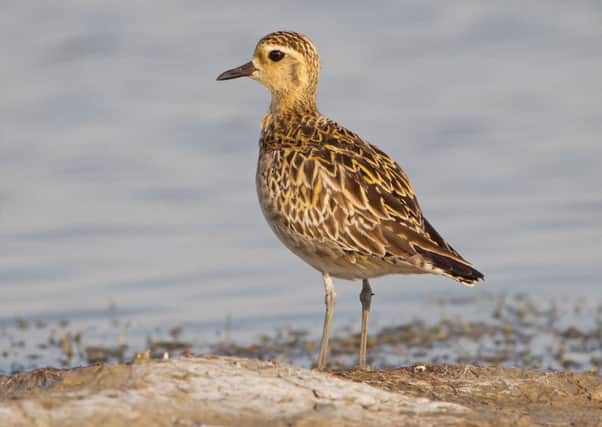Birdwatch: US trio wades in


A trio of North American waders, Pacific and American golden plovers and a white-rumped sandpiper have already been seen in Yorkshire and more might be found in the coming weeks.
The Pacific golden plover, pictured, an adult in much of its breeding plumage with black and white chequering on the head and breast, was present from late morning until teatime last Friday at the North Cave Wetland reserve, East Yorkshire before flying off among a flock of lapwings.
Advertisement
Hide AdAdvertisement
Hide AdIt breeds on the high Arctic tundra of eastern Siberia and Alaska and by now should have been starting its long migration to wintering grounds on the shores of Pacific islands or Australia and New Zealand.
The following day the American golden plover, also still in much of its summer plumage, was seen on the Humber mud from the car park at the Warren, Spurn, before it flew off further into the estuary on the incoming tide.
It also breeds on the Arctic tundra in Alaska and Canada and winters on the grasslands of central and southern South America. Both are rare vagrants to western Europe, the Pacific more so than the American, and are similar in appearance to the extent that they were once regarded as the same species, lesser golden plover.
Both are slimmer, noticeably smaller and longer legged than the European golden plover and with longer wing tips while in flight both have dusky grey underwings.
Advertisement
Hide AdAdvertisement
Hide AdThe white-rumped sandpiper has been present on the Kilnsea wetland where it was joined for a while on Tuesday by the American golden plover.
It too breeds on the Arctic tundra of northern Canada and Alaska and winters along the Patagonian coast of Chile and Argentina.
On migration it travels across part of the Atlantic so is more likely to be blown off course – as a result it is a rare but regular vagrant here.
Other waders have included wood sandpipers and a large passage of common sandpipers. There were also more green sandpipers, greenshanks, ruff, little stints, curlew sandpipers and a knot seen inland at Broomhill Flash, South Yorkshire.
Advertisement
Hide AdAdvertisement
Hide AdAn over summering black tern has continued to be seen at the St Aidan’s nature park, Leeds while other individuals were seen at the Nosterfield nature reserve North Yorkshire and Thorne Moors, South Yorkshire. A juvenile white winged black tern was seen over Kilnsea wetland. Arctic and common terns are moving south through the region while the Caspian tern, last seen at St Aidan’s last Thursday had arrived in Wales this week.
Up to four honey buzzards have been seen from the Wykeham raptor viewpoint, North Yorkshire while a black stork was also reported.